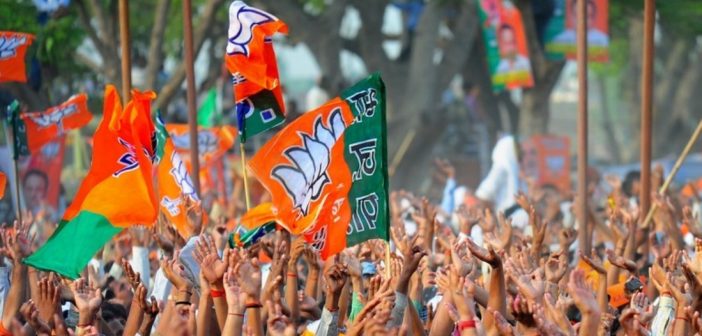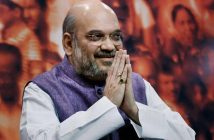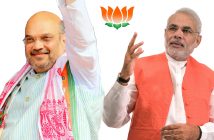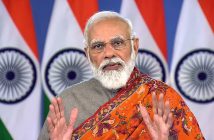BJP Politics is akin to a game of chess. Any move needs to be analysed closely as it hides more than it reveals. As the joint capital of Punjab and Haryana, Chandigarh has enjoyed a special status second only to the national capital New Delhi. Chandigarh has always been used as a sop — from the time it was carved out to compensate for Lahore City going to Pakistan.
On a languid Sunday afternoon, Chandigarh was festooned with welcome signboards and elaborate floral arrangements announcing the arrival of Amit Shah.
Little did anyone suspect the Home Minister would set the cat among the pigeons, startle Chandigarhians and local politicians alike.
Shah announced that government employees in the Chandigarh administration would now be treated as Central government staff.
This was his first visit to the City Beautiful since the drubbing received by the BJP in the Assembly polls.
This move impacts 23,000 government employees as their retirement age goes up to 60 from 58. Also, women employees would get childcare leave of two years instead of one.
Why did the BJP make this move? I believe, ahead of the 2024 Lok Sabha polls, the BJP is trying to woo UT employees.
In one dexterous move, Shah put the AAP on the backfoot, which is now looking to spread its tentacles nationwide.
Now, the Centre has become a direct stakeholder in the Chandigarh administration days after the AAP took control of the Punjab government.
Keep in mind, the demand to implement Central service rules for Chandigarh employees had been pending for nearly 25 years.
But it took a master strategist like Amit Shah to turn demand into an opportunity.
Local pundits told me this unexpected move comes after the Chandigarh municipal polls of December where despite being a BJP stronghold, the AAP managed to win 14 of the 35 wards in the city and the BJP 12 — down from 20 in the previous election in 2016.
The BJP did manage to win the mayoral post but it was a contested decision after one vote was declared invalid.
Politically, the BJP wants to stunt the AAP’s growth. It knows that after Punjab, Kejriwal would be eyeing Himachal Pradesh and Haryana.
That dream would set up the AAP as a formidable force in north India and more so in the pan-NCR region.
Putting the AAP in further trouble is the possibility that employees of the Punjab administration might demand a revision of their salary that could place additional stress on the state government, which currently has a debt burden of Rs 2.82 lakh crore.
As expected, faced with a common enemy, the Opposition huddle includes AAP, Akali Dal and Congress.
The Shiromani Akali Dal (SAD) requested Punjab chief minister Bhagwant Mann to call an all-party meeting with the objective of unitedly approaching the Centre to stop its efforts to make Chandigarh a permanent Union Territory in violation of the Punjab Reorganisation Act.
Bhagwant Mann said that Punjabis would fight for their rights.
Though Chandigarh is not part of the state, a larger percentage of Punjabi bureaucrats in the administration and application of Punjab service rules gave the state greater rights over the Union Territory.
At this point, let us take a quick detour of the earlier run-in between the Centre and the AAP government in Delhi as that casts its long shadow on this new conflict.
In my opinion, the Centre did its best to checkmate Arvind Kejriwal by portraying him as inexperienced, immature and not astute enough to occupy the chair of the chief minister of Delhi.
Ever since the AAP came to power in Delhi, diluting the powers of the AAP has been assiduously pushed as an agenda.
The Supreme Court delivered two landmark judgements making the Delhi government subservient to the office of the Lieutenant Governor.
The fight that began over Delhi seems to have now spilt over to another union territory.
The point to remember is India is a quasi-federal Constitution.
The Centre reserves powers to create states and alter their boundaries.
But to use legislative power, just because it can, also red flags issues of constitutional governance.
However, the latest Chandigarh move is the third in line by the BJP.
In October 2021, the Centre amended the rules extending the territorial jurisdiction of the Border Security Force (BSF) from 15 to 50 km. Assam and West Bengal too were impacted.
Days after the Assembly elections of February, the Centre scrapped guaranteed representation of Punjab in the Bhakra Beas Management Board (BBMB), upsetting political parties across the spectrum.
Now individuals from across the country can be nominated.
The BBMB regulates the supply of water and electricity from the Bhakra Nangal and Beas hydel projects to Punjab, Haryana, Rajasthan, Himachal Pradesh, Delhi and Chandigarh.
When Punjab was split into Punjab and Haryana with some territory going to Himachal Pradesh; at that point, both states claimed Chandigarh as their capital.
Reportedly, the boundary commission was divided over whether the area should go to Punjab or Haryana.
Pending a resolution, the Centre declared Chandigarh a Union Territory governed by the Centre but laws in force in undivided Punjab were applicable.
The home ministry’s directive said officers and employees of Chandigarh UT (including teachers and doctors) must be drawn from Punjab and Haryana in the ratio of 60:40, respectively.
Haryana was planning its own capital city but that plan did not materialise.
As late as 2018, the then Punjab chief minister Amarinder Singh opposed a suggestion by then Haryana chief minister ML Khattar for a common body to develop Chandigarh and adjoining areas saying the city belonged to Punjab.
In March 1948, the Government of (India’s) Punjab, in consultation with the Centre, approved the area of the foothills of the Shivaliks as the site for the new capital.
From 1952 to 1966 (till Haryana was carved out of Punjab), Chandigarh remained the capital of Punjab.
Again, in 1985, under the Rajiv-Longowal accord, Chandigarh was to be handed over to Punjab on 26 January 1986, but the Rajiv Gandhi government withdrew at the last minute.
As per the 1970 documents, the Centre had considered various alternatives for settling the matter, including dividing the city.
But that wasn’t feasible since Chandigarh was built as a planned city to serve as the capital of one state.
Haryana was told to use the office and residential accommodation in Chandigarh only for five years.
The Centre had offered Rs 10 crore grant to Haryana and an equal amount of loan for setting up the new capital.
To sum up, India has eight Union territories including Delhi, Jammu and Kashmir, Ladakh, Dadra and Nagar Haveli and Daman and Diu, Puducherry, Chandigarh.
After the Centre’s moves in Jammu and Kashmir, Delhi and now Chandigarh it is clear that the ruling party at the Centre if it has big numbers like the BJP does, can use the big club in de facto ways.
There is little the state government can do except ensure public sentiment turns into a serious protest.




